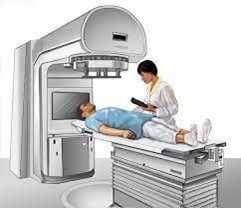The nurse is teaching a client with cancer about skincare for the portal site receiving external beam radiation. Which client action regarding skin care indicates a need for further teaching?

Applies prescribed lotions to the radiation site.
Washes the radiation site with antibacterial soap and water.
Wears clothing to cover the radiation site.
Dries the area with patting motions after taking a shower.
The Correct Answer is B
Choice A rationale:
Applying prescribed lotions to the radiation site is generally a recommended part of skin care during radiation therapy, as it helps keep the skin moisturized and reduces irritation.
Choice B rationale:
Washing the radiation site with antibacterial soap and water is not recommended. Clients undergoing radiation therapy are typically advised to use gentle, mild soaps and to avoid scrubbing or using harsh cleansers on the treated area. Antibacterial soap may be too harsh and could lead to skin irritation.
Choice C rationale:
Wearing clothing to cover the radiation site is a good practice to protect the area from sun exposure and potential irritation.
Choice D rationale:
Drying the area with patting motions after taking a shower is the correct way to dry the radiation site, as it minimizes friction and reduces the risk of skin damage.
Nursing Test Bank
Naxlex Comprehensive Predictor Exams
Related Questions
Correct Answer is C
Explanation
Choice A rationale:
Preoccupation typically involves excessive thoughts or worries about a particular topic and may not directly manifest as physical symptoms like numbness and tingling.
Choice B rationale:
Reexperience often refers to the reliving of traumatic events through flashbacks or intrusive memories and is more closely associated with conditions like post-traumatic stress disorder (PTSD).
Choice C rationale:
Somatization refers to the expression of psychological distress through physical symptoms. In this case, the client's numbness and tingling on the right side of the body may be somatic symptoms related to the psychological distress and grief experienced after the spouse's death.
Choice D rationale:
Disorganization is not typically associated with physical symptoms like numbness and tingling. It may relate to cognitive or emotional difficulties but not to these specific physical sensations.
Correct Answer is ["C","D","E","F","G"]
Explanation
Choice A rationale:
This is not a priority action for the nurse at this time. The nurse should first implement the ordered treatments for hyperkalemia and stabilize the client's condition before calling and giving a report to the receiving unit.
Choice B rationale:
Loop diuretics are medications that increase urine output and can lower potassium levels in mild cases of hyperkalemia. However, they are contraindicated in patients with ERSD who have oliguria or anuria (reduced or absent urine production). Loop diuretics can worsen renal function and fluid overload in these patients.
Choice C rationale:
Scheduling the client for hemodialysis is crucial, especially if the client has missed a scheduled dialysis session. Hemodialysis can help manage electrolyte imbalances and fluid overload.
Choice D rationale:
Checking the blood glucose level is important, especially in a client with a history of diabetes. Maintaining glycemic control is essential for overall health.
Choice E rationale:
Drawing a repeat potassium level is necessary to monitor the client's electrolyte status, especially given the ECG changes.
Choice F rationale:
Holding Lisinopril, an ACE inhibitor, is appropriate in this context, considering the client's elevated blood pressure and potential renal issues. It should be done under the guidance of the healthcare provider.
Choice G rationale:
Administering insulin, dextrose, and calcium gluconate can help manage hyperkalemia, which may be indicated by the ECG changes. Repeating the 12-lead EKG is important to assess the response to treatment and any changes in cardiac rhythm.
Whether you are a student looking to ace your exams or a practicing nurse seeking to enhance your expertise , our nursing education contents will empower you with the confidence and competence to make a difference in the lives of patients and become a respected leader in the healthcare field.
Visit Naxlex, invest in your future and unlock endless possibilities with our unparalleled nursing education contents today
Report Wrong Answer on the Current Question
Do you disagree with the answer? If yes, what is your expected answer? Explain.
Kindly be descriptive with the issue you are facing.
